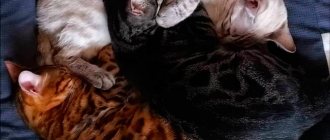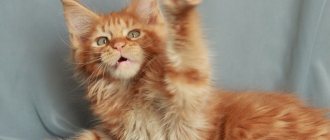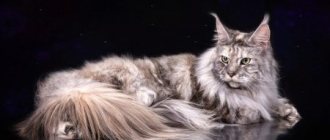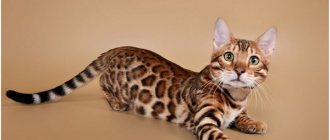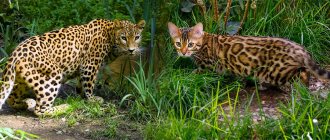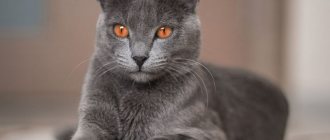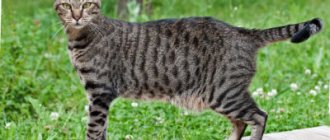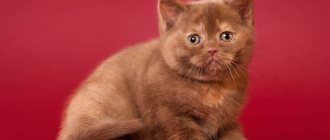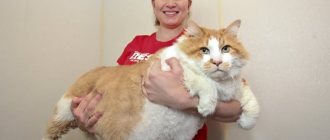Coat and color are a distinctive feature of the Bengal cat. Each pattern is individual: spots or stripes on a cat are like fingerprints on a person; no two are alike. Today, there are many colors of Bengal cats. The Snow Bengal stands out among all of them; it is even sometimes confused with another breed. Every cat lover dreams of having a little “leopard” at home.
Color standards
Outwardly, the Bengal cat always resembles its wild ancestors. On the muzzle there are contrasting dark stripes that resemble the letter “M” on the forehead. Light-colored whisker pads. The contours of the nose, lips and eyes are black or darker. Dark stripes on the neck, like a necklace, decorate it. There are often small stripes on the paws, but there may also be spots. The tail is also spotted or rosette, but its tip always remains black. All breeders strive to get as close as possible to the appearance of a wild cat. Therefore, the spotted belly and chest should preferably be lighter. It is not always possible to achieve such selective lightening - scientists still cannot definitively determine the gene that is responsible for this.
The colors of Bengals are distinguished by the color of the background and the type of pattern that is located on it. The most common are gold and silver backgrounds. There are snow bengals, among which there are lynx, mink, and sepia. The charcoal color is considered more rare. The blue color is also officially recognized.
Character and behavior
Despite its predatory appearance, the leopard-colored cat is quite friendly. They are friendly and not aggressive with their owners. They may show some wariness with strangers, but this is a normal reaction. also necessary to remember that these cats have a strong hunting instinct . For this reason, if you plan to “keep a leopard,” there is no place for feathered pets and rodents in the house.
By nature, Bengals are extremely responsive and devoted to their owners. This is one of the few breeds whose representatives really need to communicate with people. A leopard-colored cat is very active and will explore all the furniture in the house with interest.
Therefore, in order to avoid damaged furniture, it is better to buy her several toys. It is desirable that they be on a stick and make rustling sounds.
These animals, in terms of the range of sounds they make, are very similar to a tiger. They love to meow, thus communicating with their owners, or growl while eating.
© shutterstock
What should you pay attention to?
A Bengali needs to be raised from an early age. Including:
- You need to politely but firmly show your pet what behavior is acceptable. At the same time, leopard-colored kittens, like small children, can continue to repeat their pranks.
- You should take your pet in your arms and stroke it more often. As adults, they are no longer as fond of frequent petting. Therefore, if you do not want your leopard cat to grow up wild and ill-mannered, it is important to give him enough attention from an early age.
- Kittens quickly become accustomed to the litter box. Considering that they really like to bury something, the best filler would be clean sand or a material with a similar structure.
- Don't be surprised if your pet asks for a bath on its own. This is a common occurrence. Leopard cats are big fans of water treatments. They love not only to swim, but also to play funny games with water.
- Bengals, as already noted, love various toys. But these should not be simple objects like balls. This is due to the fact that this breed has a very developed intelligence, so they find it boring to play with simple things.
- It is unacceptable to show aggression towards cats of any breed, and especially towards Bengals. You can try this trick: clap your hands and say “ugh.” It may take several of these repetitions before the kitten remembers the lesson.
In general, these cats have developed intelligence, so they easily remember and follow commands. Important factors are: whether the animal was accustomed to home conditions before selling or not, and at what age the pet was taken into the home. A cat that is housetrained and adopted at an early age (before it turns one year old) will have an easier time adapting.
As soon as a little Bengal appears in your home, it is important to take a responsible approach to his upbringing.
Veterinarians recommend using special commands, for example, “no!” This way, the pet will be able to understand what the owner expects from him. The Bengal cat breed should never be subjected to violence. It must be remembered that her distant ancestor is a wild predator, and, therefore, natural instincts can awaken in her.
What to feed?
Bengals have a very sensitive digestive system due to their shortened intestines. They inherited this feature from their wild ancestors. It is important to carefully introduce new foods and feeds into the diet of leopard cats . Otherwise, both diarrhea and more serious stomach problems may occur.
The following feeding options are possible:
- natural products – poultry, meat;
- industrial feed;
- combination of natural food and special feed.
The best option would be a balanced diet, including natural food and high-quality feed. It may happen that the pet does not want to eat the food intended for it at all. In this case, you need to listen to his wishes and add a special vitamin and mineral complex for animals to the food.
© shutterstock
Pattern: spotted or marbled
Cat coloring is divided into two types:
- Spotted (from English spotted) or rosette (from English rosetted) pattern. In the first case, these are solid spots. In the second, the so-called sockets. The color inside the rosette should be darker than the background, which is completely or partially surrounded by a darker circle (closed and open rosette). The size of the spots or rosettes can range from small to large.
- Marble (from English marbled) pattern: represents various horizontal stripes. Circular or vertical marks are faults. It is more highly valued when the marble pattern of the Bengal contains three colors: the background shade, the pattern and its edging.
To distinguish the colors of Bengal cats, it is easier to use the table:
Life in captivity
A spacious enclosure is being prepared for the Asian leopard cat, which has not been raised by humans and has retained its wild habits. Its height is at least 2 m, length 4–5 m. The metal mesh roof is half covered with rainproof material. Two dens are arranged under it so that the animal can choose where to be. They are made in the shape of a sleeve or a house. Wooden parts are used for manufacturing.
Bushes and palm trees are planted inside the enclosure. It is better to equip a pond with a fountain in the center, decorating it with large shellfish shells. 5–8 shelves and bridges are attached to the sides of the enclosure at a height of 0.3–0.6 m from each other. One bed should be fully illuminated by the sun. Sawn logs are installed at an angle or placed on the floor. They add an imitation of rocky terrain and one or two ladders. Covered litter trays are installed in all corners of the enclosure so that the animal can mark its territory.
For physical health, savages organize hunting with feeding of live prey. To do this, cover the side walls of the enclosure with triplex at a height of up to 35 cm from the floor and install a door. They release a rodent. The cat will not only run around to its heart's content, but will also receive moral pleasure.
When keeping one animal at home, at least 6 hours of play time is required daily. Otherwise, boredom will cause your pet’s behavior to deteriorate. It is ideal to foster two Asian leopard cat . This is the best way to keep them active and occupied. Even constantly adding new toys will not cope with this task. If good conditions are created for the animals, the life expectancy will be 12–14 years.
It is better to start the vaccination schedule at 3.5 months so that the kitten is sufficiently old and strong. At this age, his teeth are fully formed. Leopard cats do not carry diseases that are dangerous to humans. However, they are predisposed to the immunodeficiency virus (VIP). Having become infected from domestic animals, spotted inhabitants of the tropics quickly die from the disease. Due to genetic characteristics, their body is powerless against this infection.
The Asian leopard is for those who do not want an interior cat, but an interesting creature. You need to play with her a lot, come up with puzzles, train and communicate. Always nearby and wants to know what you are doing. You will have to adapt to this cat and change your lifestyle. And you need to be prepared for this.
NatalySeed
https://irecommend.ru/content/bengal-f1-slozhnaya-poroda-dlya-uvlechennykh-lyudei
The necessary conditions
In captivity, the Asian leopard cat is kept warm. Optimal air humidity is 75%. This animal is from tropical latitudes, where at night it is not lower than +15°C. Heating the house or shelves partially solves the problem, but in the cold season the animal is moved from the enclosure indoors. Cages measuring 118x78 cm are installed in a bright, spacious room. They are covered on top with blankets filled with padding polyester. A closed toilet and a scratching post are placed nearby.
Wild leopard cat loves to watch from above
In nature, a wild leopard cat has several secluded places in its territory. It is advisable to make the floor in the room from a smooth and waterproof material so that regular cleaning is convenient. Complexes with climbing arms, hanging balls, and squeaker mice will entertain your spotted pet. But a wild cat will be active only with the participation of the owner in its games.
Video: communication between a tamed kitten and a person
Adult animals are fed once or twice a day. They give you a raw egg, a chicken carcass with feathers and entrails. A delicacy is live quails and mice. Pieces of beef containing tendons add variety to the menu. Premium wet canned meats will do. Amount of food - up to 250 g per day.
The pet is weighed regularly. If body weight does not increase and the cat runs a lot during the day, then weekly daily fasting is not necessary. It is enough to reduce the portion by half or give fish that day.
Snow Bengal
Snow color is one of the rare ones. Snow Bengal kittens are divided into three groups depending on their genotype.
Links (Ben n 33) The background is represented by shades of cream or ivory. The pattern varies in tones of brown from light to dark. The head and paws are darker than the body. The tail is brown. These are the only snow bengals that are born completely white, and the pattern does not appear until they are one year old.
Mink (Ben n 32) They are often confused with the link color. The drawing from birth practically merges with the background and is hardly noticeable. The main difference is the eyes: their color varies from bright green to blue.
Sepia (Ben n 31) The color is lighter than golden, but darker than other snow Bengal cats. The difference between the background and the picture is small. The pads on the paws are brown, as is the tip of the tail. Eye colors include variations of green and yellow.
Diet
The Asian cat is a predator; its menu contains only animal food. In captivity, you need to feed a leopard cat:
- Lean meat (beef, veal, poultry, rabbit).
- Live food (mice, rats, day-old chicks).
- Low-fat fish.
Feed is given once a day. This rule does not apply to pregnant cats and kittens under six months of age. They are fed two or three times.
The optimal portion for a domesticated predator is 200 grams of meat, one live rat or two mice. Live food is necessary to maintain the normal physical and mental condition of the pet. Dulling of hunting instincts leads to deviations in behavior.
The animal may develop obesity and associated diseases. This leads to the death of the leopard cat.
To prevent obesity, breeders recommend giving your pet fasting days. Once a week the animal is left without food. This will not harm its health, since in captivity the predator spends several times less energy than in the wild.
Fasting days are prohibited for:
- Pregnant cats.
- Small kittens (up to 6 months).
- Sick animals.
Some breeders arrange an additional half-starvation day. The portion for the pet is reduced to half (100 grams of meat and one mouse).
It is recommended to give fish to Asian leopard cats no more than once a week. Its predominance in the diet leads to the leaching of calcium from the animal’s bones and rickets.
If it is not possible to feed your Asian with live food, introduce chicken feet, heads, liver and heart into his diet. This food contributes to the proper functioning of the predator’s digestive system.
In captivity, cats often abandon their kittens. You can feed them by diluting special dry cat milk. Goat's milk or baby formula will do. If possible, it is better to give the kitten to be “fostered” by a recently lambed domestic cat.
Mixed bengal cat
Bengals are prohibited from crossing with other cat breeds. This is fraught with sick or completely non-viable offspring. However, some engage in this activity for commercial purposes. Such kittens can be found through frequent advertisements on the Internet. We warn you! Mixed breeds of the Bengal cat are not officially recognized. Such kittens do not belong to the Bengal breed. As a result, you can get a kitten that will not meet external standards, but also its character. Breeders carefully select affectionate and non-aggressive representatives. Otherwise, the genes may take over and you will end up with an uncontrollable animal. Long-haired mixed breed (cashmere bengal, silk bengal) is gaining popularity. The animal has a similar color. It is distinguished by a fluffy tail, a “collar”, and longer hair on the sides and back.
Origin story
In the middle of the last century, the Asian leopard was on the verge of extinction. This is because their skins were of great value. They have a traditional golden brown color. Leopard fur feels like silk to the touch.
A scientist from the United States of America, Jean Mill, decided to save this breed from complete extinction. And she began work on breeding this breed of cats through natural crossing.
For selection, she used a representative of the wild and an ordinary domestic cat. At the beginning, her experiments were not crowned with success; the resulting kittens were very aggressive and did not make contact well with people.
However, after 20 years of experiments, she managed to develop a new breed.
The domestic Bengal cat breed has a vibrant, shiny coat along with wild spotted patterns.
Cat care
Caring for Bengal cats is not much different from regular animal care. It is necessary to carry out vaccinations on time, buy proper food, and bathe several times every 2 months.
You need to play with cats so that they expend their energy. If you raise a cat with love, he will grow up to be a real pet leopard.
Phasing in Bengal cat kittens
The thin, sparse, light-colored fluffy coat that appears in kittens immediately after birth is a natural defense in the wild. Bright spots can reveal a kitten of a forest animal to its predatory enemies. A unique means of camouflage in children is preserved in generations that are no longer hybrids. As kittens grow up, they get rid of the hairs that cover spots or stains. On a light base background, kittens have less phasing coat. By the age when kittens enter the young stage, their attractive “leopard” appears more clearly. There are known cases of reappearance of phasing fur if kittens were born with a camouflage coat. If the temporary hairs do not fall out, the Bengal kitten is rejected from among the purebreds.
The variety of colors of Bengals is understandable: this is a young breed that carries the genes not only of the Asian leopard cat, but also of a whole list of domestic breeds - American shorthair, Egyptian Mau, Abyssinian, etc. Each species brought its own genes, and in mixed matings this always gives amazing results . It will not be strange that in the future many of the currently non-standard Bengal colors will be recognized in felinology.
Considering that the fur of animals from this cat family usually has a beautiful shine, noticeable in sunlight, the attention of professional breeders and lovers of domestic tailed animals to the new breed is understandable. The variety of colors and patterns of Bengal cats is the result of the passionate and painstaking work of breeders who are constantly working to improve the standard, resulting in exotic, rare colors of Bengal cats and cats.
How to buy a Bengal kitten and what is its cost
There are many nurseries in Russia where you can purchase a Bengal kitten. However, despite the fairly wide distribution of the breed, it is unlikely that you will be able to save money on it - unless, of course, you want to become the owner of a truly thoroughbred animal.
Before purchasing, you should find out as much information as possible about the future pet: its pedigree, character traits, general interesting facts about the breed, the subtleties of interaction between humans and Bengals. As for the price of a Bengal cat, you should know that this breed is among the top most expensive. In our country, the cost of an animal ranges from 25 thousand to 100 thousand rubles.
This is primarily due to the difficulties with breeding Bengals. The first generation of male kittens remains infertile, while their sisters are crossed with full-fledged representatives of the breed, after which a second generation is obtained, most of the males of which are also infertile. In the third generation, a minority of males already suffer from infertility, but only in the fourth generation are kittens considered full-fledged representatives of the breed. Now you know almost everything about this magnificent spotted kitty: although in order to decide whether it is worth reviving your home with it in the near future.
Number and protection of Asian leopard cats
In nature, the enemies of the leopard cat are all larger predators than itself, but due to its secrecy and dexterity, it rarely ends up with them for dinner. Unfortunately, the main enemy for this species is humans, who have long hunted the ALC for its beautiful spotted fur. In addition, local residents of Asian regions killed Bengal cats for meat or out of revenge for ruined poultry houses. Poachers have made and are still making their contribution by catching kittens and adult animals for sale to lovers of live exotic animals.
Poachers often catch small wild kittens and pass them off for sale as kittens raised in special nurseries, but such kittens forever remain predators and are not able to adapt to life in a human home
Human activities are actively changing the habitat of Asian leopards, which also contributes to a decrease in their population. ALCs were classified as an endangered species, and certain species, for example, the Far Eastern cat, were listed in the Red Book. In 2006, 169 countries joined the CITES wildlife treaty, which regulates international trade in rare species of flora and fauna. Wild Bengal cat species are included in Appendices 1 and 2 of this agreement as endangered species not subject to trade and species not yet in danger of extinction but whose trade should be limited. Since the agreement was signed in 1973, not a single species listed in CITES has gone extinct. At this time, Asian leopard cats are not considered to be endangered. Nevertheless, these beautiful, independent and fragile predators must be protected.
How to choose a cat?
For Eastern Europe, the breed is quite rare, so there are certain difficulties in purchasing kittens.
There is a huge risk of buying a fake in the form of an ordinary European cat with a color similar to a Bengal.
In order not to be disappointed in your purchase, you should contact a cattery that is registered with the National Union of Cat Clubs.
And remember, mini-leopards cannot cost a penny; do not respond to tempting offers “I’ll give them to good hands” or “due to a sudden departure.”
When choosing a pet, look at the conditions in which it is kept, whether vaccinations have been given, how active and playful the kitten is.
When choosing a pet, look at the conditions in which it is kept, whether it has been vaccinated, and how active and playful the kitten is.
Check your baby especially for aggressiveness. A good breeder socializes Bengals from an early age.
An important point is color. This is what it comes in, and you choose according to your preferences.
